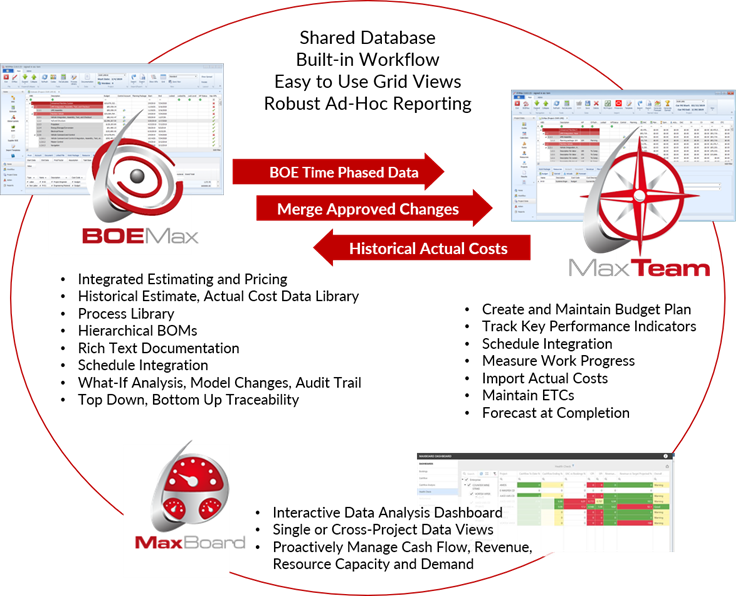When we incorporated ProjStream over 10 years ago, our mission was to bring to life a vision of bridging the gap between project cost estimating, pricing, and cost management with a shared database for the entire project life cycle. We wanted to create a software solution to help companies establish a closed loop process for creating realistic cost estimates and executable budget plans after contract award.
So, why the vision? We have first-hand experience with how difficult it is to develop a quality cost estimate and price it using Excel or ad-hoc tools, as well as the obstacles for accessing a reliable set of historical data to substantiate a basis of estimate. We have also been on the project execution side where we often needed to re-create the baseline schedule and time phased budget plan after contract award because it was easier than trying to decipher what the proposal team had put together. We knew there had to be a better way – and single point software solutions that created isolated pockets of data were clearly part of the problem.
Limitations of Single Point Solutions
It is easy to settle into single point solutions for cost estimating, pricing, and project cost management without thinking about the complete picture because most companies are organized into functional silos. That includes corporate business systems as well as people. By default, these functional silos segregate and organize data for a specific business use. It is not easy to share data between systems.
The proposal team isn’t thinking about what would be useful to the project control team after contract award. They have a deadline to get the proposal out the door in a format the customer wants. They have enough on their plate pulling together all the proposal pieces – often a raft of ad-hoc Excel spreadsheets with estimating and pricing data, basis of estimate supporting documents, bills of material, supplier data, and other details.
On top of that, the proposal team is often so focused on merging spreadsheets, they have limited time to verify the complete set of data. Is the cost estimate realistic? How do they know? Can someone follow the basis of estimate rationale? Is the cost estimate traceable from the top down and bottom up? Is the proposal schedule and cost estimate in alignment? Did they pick the best pricing strategy? If they don’t have a realistic cost estimate to begin with, how do they know?
No wonder the project control team can’t make heads or tails of the proposal content when it isn’t organized so they can use the proposal schedule and cost estimate data for the project startup phase. The time and effort spent to create and substantiate the basis of estimate including risk assessments is lost. The project control team doesn’t have the benefit of the thought process the proposal team and supporting technical personnel went through to produce the proposal submission. That would have been useful data and information so they could create an executable schedule and budget baseline.
The project control team also isn’t thinking about what be helpful to a proposal team to substantiate a basis of estimate for similar work tasks. They are focused on what is going on with the project and managing technical, schedule, and cost objectives. As work progresses, they often discover the baseline schedule and budget were overly optimistic, they don’t have key resources available when they need them, they didn’t account for rework, or run into other issues they didn’t identify as potential risks.
The original and revised budget, resource plan, actual costs, performance data, and reasons for baseline changes is all useful information a cost estimator could use to create a more realistic cost estimate for the next proposal. The problem is the cost estimators don’t have access to the historical data they need to substantiate their basis of estimate.
In addition, corporate and functional managers don’t have visibility into the proposal or project work and financial performance data. This includes resource capacity and demand across pipeline and active projects. Demand for key resources often create single points of failure that are difficult to overcome unless management is able to plan ahead to mitigate the issue. There is no way to create a complete view of project data when it is siloed into single point solutions.
Benefits of Merging Point Solutions
Having walked in the shoes of proposal managers, cost estimators, project managers, and project control personnel, it made logical sense to us to create a shared database for the complete project life cycle.
Starting with BOEMax, we created an integrated cost estimating and pricing solution. Our goal was to help proposal teams organize their data and basis of estimate narrative text using the framework of the WBS as well as manage the development process with built-in workflow and robust reporting. The MaxTeam project cost management solution was a natural extension of the BOEMax database. Our goal was to help project control teams manage their project’s time phased data such as budget, earned value, and actual costs along with performance metrics for the project execution phase. MaxBoard was the finishing piece for management so it is easy to create a variety of data views across pipeline and active projects.
The following image illustrates the relationships between our integrated tools to help our clients create a closed loop cost estimating and project control process.

In bringing our vision to life, our core objectives were to:
- Make it easy for proposal teams to create data driven cost estimates complete with narrative text and bi-directional schedule integration. Our goal was to help them produce a realistic cost estimate based on a good understanding of the scope of work, complexity, resource requirements, and risk factors. As an example, we incorporated powerful search capabilities so proposal teams can locate potential analogous tasks, evaluate them for relevance, and copy the tasks they need into their proposal project. They can search other proposal projects as well as completed or active projects – they can easily access reliable source data for their basis of estimates.
- Make it easy for project control teams after contract award to use the proposal cost estimate and basis of estimate to quickly create an executable budget baseline with clear accomplishment criteria for the execution phase. They can track baseline changes along with rationale, measure work performance, collect actual costs, and maintain the project’s estimate to complete as well as forecast the cost at completion. We included the ability to track cash flow and revenue for a more complete picture of the project’s financial performance throughout the life of the project.
- Leverage the shared database to create interactive data views across pipeline and active projects so a variety of managers have reliable source data for visibility and control. They can analyze work and financial performance metrics, establish their own project performance indicators, or plan ahead for changing resource capacity and demands across a portfolio of projects.
- Use an agile software development process to quickly address software issues and deliver enhancements. There is only one core product build for all of our clients. That way we can easily broaden software functionality and rapidly deploy enhancements to meet client business needs. The products naturally evolve to support a variety of clients across industry verticals. We know how frustrating it is to deal with software vendors who take months to respond to an issue or years to incorporate an enhancement request. We never resort to add-ons or one-off solutions that create more problems for clients.
- Use an open architecture and current technology so we can proactively support different environments such as deploying our tools in the cloud, web services, and data access from mobile devices – that was designed in from the beginning. Other software vendors are trapped in old technology or legacy databases they attempt to meld together with data integration utilities and patchwork user interfaces. It is difficult for legacy software vendors to adapt to rapidly changing technology or cyber security requirements.
Give us a call today to see how BOEMax, MaxTeam, and MaxBoard can support your proposal and project cost management processes, bridge the gap between systems, and improve data quality. Our goal is to simplify life for the proposal and project control teams with a shared database for the complete project life cycle.
Updated September 25, 2020


